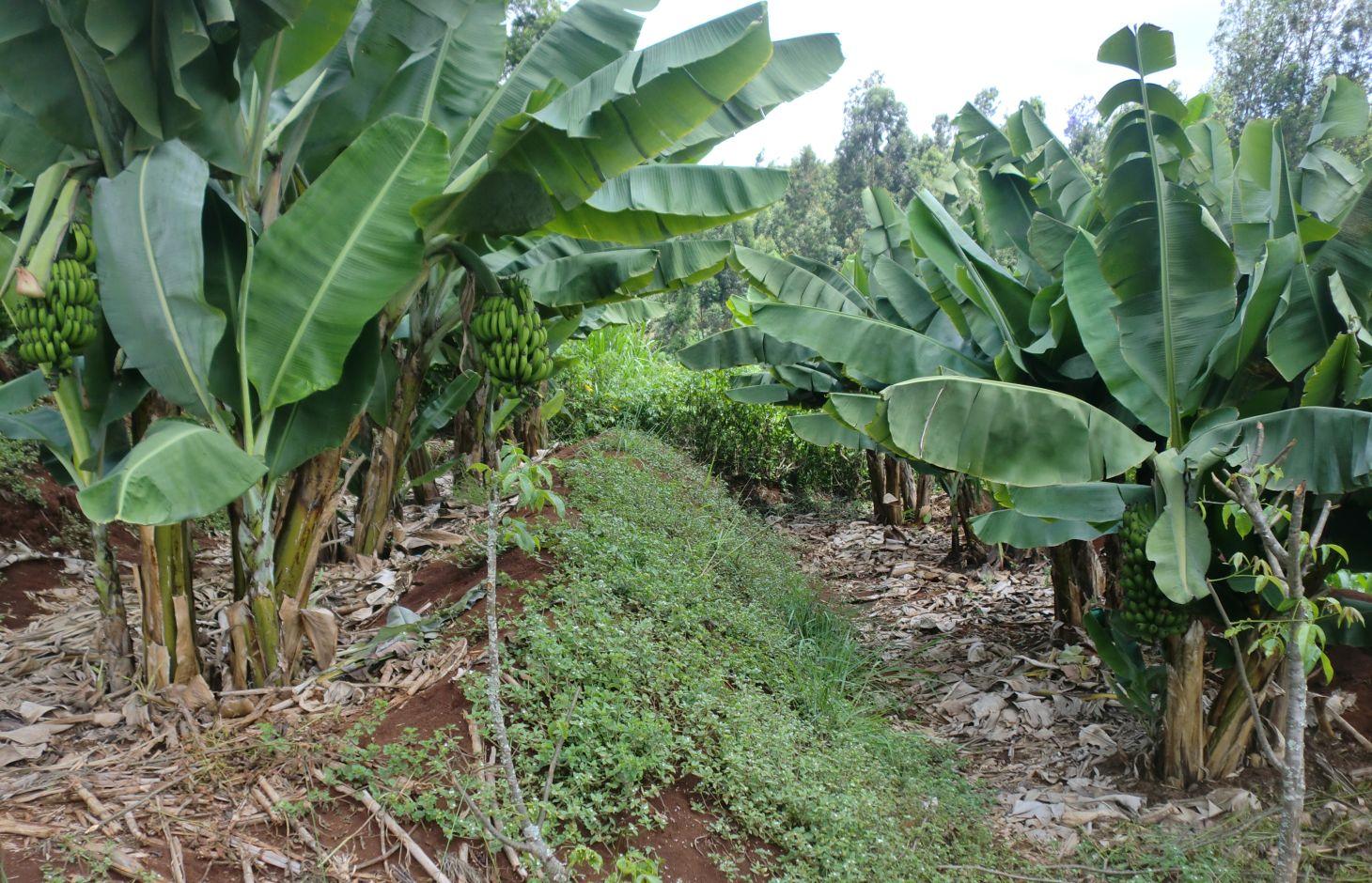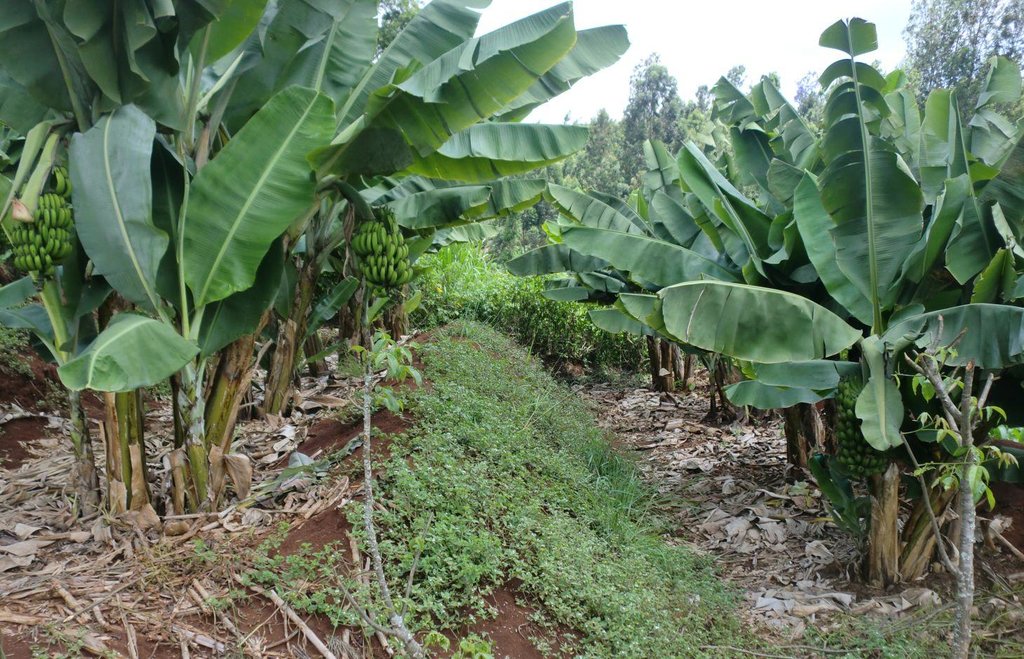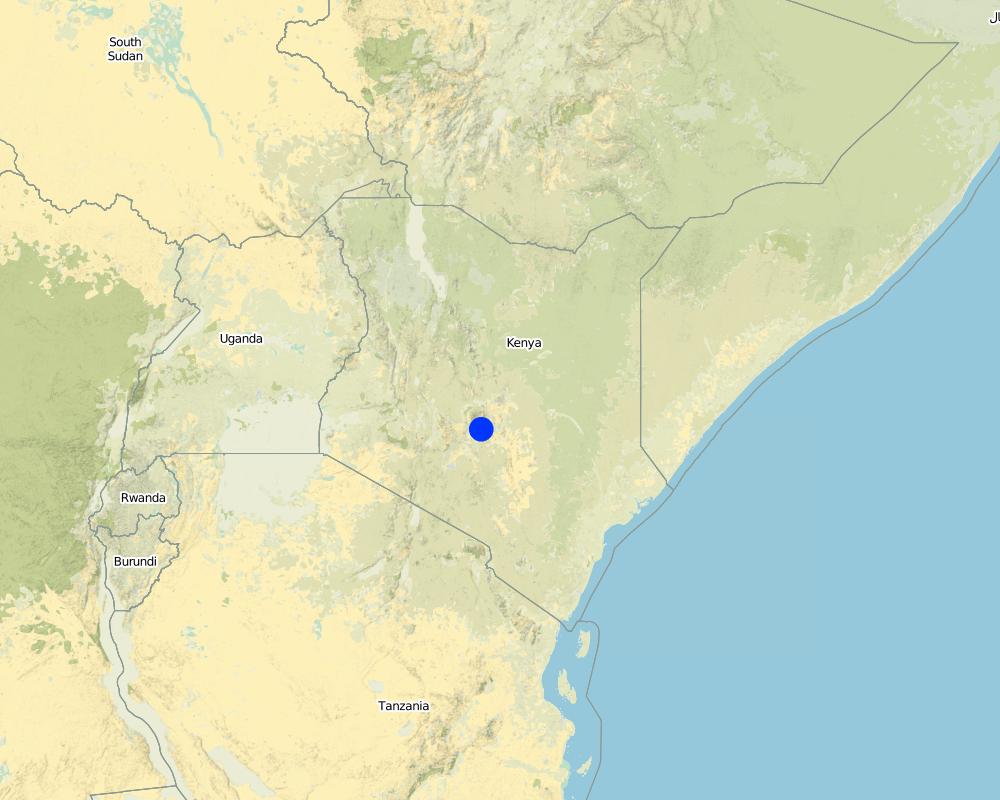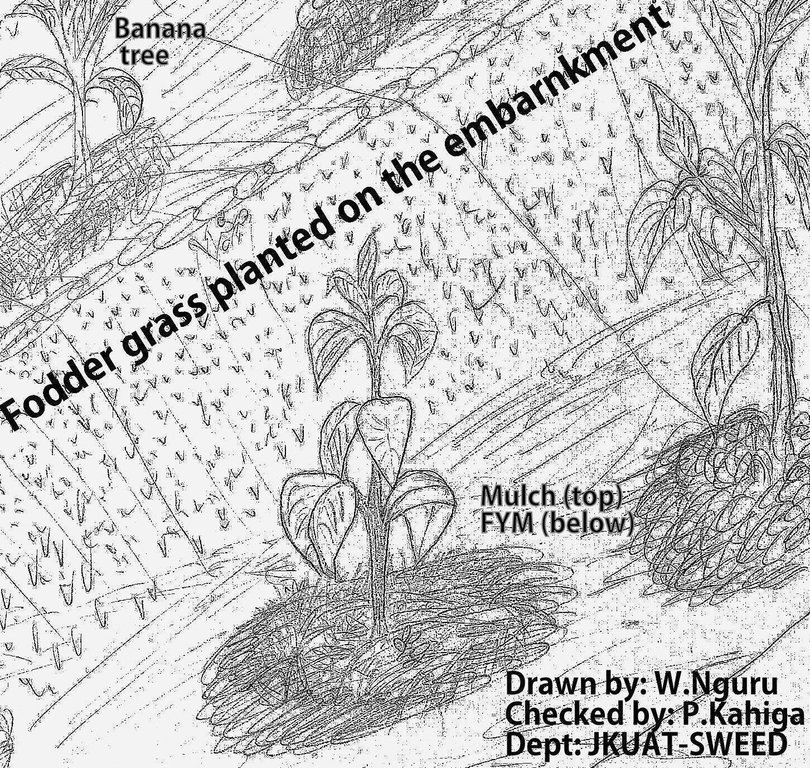Mulching [Kenya]
- Creation:
- Update:
- Compiler: Paul Kahiga
- Editor: –
- Reviewer: Fabian Ottiger
Mulching
technologies_1318 - Kenya
View sections
Expand all Collapse all1. General information
1.2 Contact details of resource persons and institutions involved in the assessment and documentation of the Technology
SLM specialist:
Gathenya Mwangi
Jomo Kenyatta University of Agriculture and Technology
P.O.Box, 62000-00200, Nairobi, Juja, Kenia
Kenya
SLM specialist:
Home Patrick
Jomo Kenyatta University of Agriculture and Technology
P.O.Box, 62000-00200, Nairobi, Juja, Kenia
Kenya
SLM specialist:
Chege Timothy
Jomo Kenyatta University of Agriculture and Technology
P.O.Box, 62000-00200, Nairobi, Juja, Kenia
Kenya
SLM specialist:
Wamuongo Jane
+254 729 054547
Kenya Agricultural Research Institute
Kenya
SLM specialist:
Karanja Andrew
+254 729 054547
Kenya Agricultural Research Institute
Kenya
Name of the institution(s) which facilitated the documentation/ evaluation of the Technology (if relevant)
Jomo Kenyatta University (Jomo Kenyatta University) - KenyaName of the institution(s) which facilitated the documentation/ evaluation of the Technology (if relevant)
KARI Headquarters (KARI Headquarters) - Kenya1.3 Conditions regarding the use of data documented through WOCAT
When were the data compiled (in the field)?
09/02/2011
The compiler and key resource person(s) accept the conditions regarding the use of data documented through WOCAT:
Yes
1.4 Declaration on sustainability of the described Technology
Is the Technology described here problematic with regard to land degradation, so that it cannot be declared a sustainable land management technology?
No
2. Description of the SLM Technology
2.1 Short description of the Technology
Definition of the Technology:
Mulching is done by covering the soil surface between crop rows, around trees (mostly fruit and orchard) or vegetables with cut grass, crop residues, straw or other plant material in order to retain soil moisture, prevent or suppress weed growth and enhance soil structure.
2.2 Detailed description of the Technology
Description:
A layer of crop residues, cut grass, straw or other plant material is spread on the soil surface between crop rows or around the vegetables or orchard trees in order to retain the soil moisture by limiting evaporation, prevents weed growth and enhances soil structure. Farmers in the Upper Tana Catchment mostly uses crop residues as mulch especially after the harvesting season. Banana leaves in Embu county are used as mulch on banana plants.
Purpose of the Technology: Mulching is mostly used in the Upper Tana Catchment to retain soil moisture by limiting evaporation, it also prevents weed growth and enhances soil structure. It is commonly used in areas that are mostly affected by drought and weed infestation. In Embu District, mulch on banana plantations is supplemented with farm yard manure as shown in the photographs above. The most readily available source of mulching materials is banana leaves themselves even though other type of mulch materials are also in use. Some farmers use the these leaves both as mulch and as livestock feeds during the drought seasons.
Establishment / maintenance activities and inputs: The mulch layer is rougher than the surface of the soil and thus inhibits runoff. The layer of plant material protects the soil from splash erosion and limits the formation of soil crust. It is worth to note that the choice of mulch depends on locally available materials. In alley-cropping systems, hedgerow biomass is often used as mulch. Another strategy is to leave crop residues, such as maize stalks on the ground after harvesting. Mulch can be spread on a seedbed or around planting holes. Large pieces of crop residues should be cut into smaller pieces before spreading on the soil's surface. There are many advantages of using mulch which include, increase of soil moisture, reduction of excessive evaporation from the soil surface, suppression of weeds which further reduces labour cost of weeding. Mulching reduces high fluctuations in soil temperature, which means improved conditions for microorganisms in the soil. It also increases soil organic matter and thereby improves soil structure. Mulch protects the soil against splash erosion and runoff. The disadvantages of mulch includes the following; unavailability of suitable materials for mulch, some seeds of mulch might germinate and become weed problem. If crop residues are used as mulch it might mean a loss of animal fodder. Especially in the drier parts of Mbeere district, dry mulch has been reported as fire hazard. Sometimes it is difficult to spread mulch on steep slopes and it can also be a possible habitat for pests and diseases.
Natural / human environment: Areas with limited rainfall usually respond very well to mulching. Mulching is not applicable in wet conditions however, the soils should have good drainage.
2.3 Photos of the Technology
2.5 Country/ region/ locations where the Technology has been applied and which are covered by this assessment
Country:
Kenya
Region/ State/ Province:
Eastern Province
Further specification of location:
Embu North District
Map
×2.6 Date of implementation
If precise year is not known, indicate approximate date:
- 10-50 years ago
2.7 Introduction of the Technology
Specify how the Technology was introduced:
- through land users' innovation
3. Classification of the SLM Technology
3.1 Main purpose(s) of the Technology
- improve production
- conserve ecosystem
- preserve/ improve biodiversity
- create beneficial economic impact
3.2 Current land use type(s) where the Technology is applied

Cropland
- Annual cropping
Main crops (cash and food crops):
Major cash crop: Coffee
Major food crop: Bananas, maize and vegetables
Comments:
Major land use problems (compiler’s opinion): Soil erosion, weed infestation and excessive evaporation in the farm lands
Major land use problems (land users’ perception): Low soil fertility and excessive evaporation of soil moisture
3.3 Further information about land use
Water supply for the land on which the Technology is applied:
- rainfed
Number of growing seasons per year:
- 2
Specify:
Longest growing period in days: 180, Longest growing period from month to month: April to October
3.4 SLM group to which the Technology belongs
- improved ground/ vegetation cover
3.5 Spread of the Technology
Specify the spread of the Technology:
- evenly spread over an area
If the Technology is evenly spread over an area, indicate approximate area covered:
- 1-10 km2
Comments:
Most of the farmers use mulch from their crop residuals
3.6 SLM measures comprising the Technology

agronomic measures
- A2: Organic matter/ soil fertility
Comments:
Type of agronomic measures: mulching, manure / compost / residues
3.7 Main types of land degradation addressed by the Technology

soil erosion by water
- Wt: loss of topsoil/ surface erosion

chemical soil deterioration
- Cn: fertility decline and reduced organic matter content (not caused by erosion)
Comments:
Main causes of degradation: crop management (annual, perennial, tree/shrub)
Secondary causes of degradation: soil management, deforestation / removal of natural vegetation (incl. forest fires), overgrazing
3.8 Prevention, reduction, or restoration of land degradation
Specify the goal of the Technology with regard to land degradation:
- prevent land degradation
- reduce land degradation
4. Technical specifications, implementation activities, inputs, and costs
4.1 Technical drawing of the Technology
4.2 Technical specifications/ explanations of technical drawing
The technical drawing on the left shows banana trees planted on benches. Fodder grass that is used to feed livestock is planted to stabilize the slopes. FYM is first spread at the base and latter covered with mulch made from the banana leaves.
Location: Embu North. Eastern Province
Date: 06/09/2016
Technical knowledge required for field staff / advisors: low
Technical knowledge required for land users: high
Main technical functions: control of raindrop splash, control of dispersed runoff: retain / trap, improvement of ground cover, increase of infiltration
Secondary technical functions: control of dispersed runoff: impede / retard, control of concentrated runoff: retain / trap, increase of surface roughness, increase in organic matter, increase of groundwater level / recharge of groundwater, reduction in wind speed
Mulching
Material/ species: Banana leaves
Quantity/ density: 2
Remarks: mulch is spread on the surface surrounding the banana trees
Manure / compost / residues
Material/ species: Farmyard Manure
Quantity/ density: 1
Remarks: Farm yard manure is first applied around the banana tree then the mulch is spread over
4.3 General information regarding the calculation of inputs and costs
other/ national currency (specify):
Kshs.
Indicate exchange rate from USD to local currency (if relevant): 1 USD =:
100.0
Indicate average wage cost of hired labour per day:
400.00
4.4 Establishment activities
| Activity | Type of measure | Timing | |
|---|---|---|---|
| 1. | Apply banana leaves and FYM | Agronomic |
Comments:
Lifespan of the leaves: 1 year
4.5 Costs and inputs needed for establishment
| Specify input | Unit | Quantity | Costs per Unit | Total costs per input | % of costs borne by land users | |
|---|---|---|---|---|---|---|
| Labour | Labour | ha | 1.0 | 50.0 | 50.0 | 100.0 |
| Equipment | Tools | ha | 1.0 | 10.0 | 10.0 | 100.0 |
| Fertilizers and biocides | Compost/manure | ha | 1.0 | 10.0 | 10.0 | 100.0 |
| Total costs for establishment of the Technology | 70.0 | |||||
Comments:
Duration of establishment phase: 1 month(s)
4.6 Maintenance/ recurrent activities
| Activity | Type of measure | Timing/ frequency | |
|---|---|---|---|
| 1. | Cutting the banana leaves and applying FYM | Agronomic | one in every six months |
4.7 Costs and inputs needed for maintenance/ recurrent activities (per year)
| Specify input | Unit | Quantity | Costs per Unit | Total costs per input | % of costs borne by land users | |
|---|---|---|---|---|---|---|
| Labour | Cutting the banana leaves and applying FYM | ha | 1.0 | 4.0 | 4.0 | 100.0 |
| Equipment | Tools | ha | 1.0 | 10.0 | 10.0 | 100.0 |
| Fertilizers and biocides | Compost/manure | ha | 1.0 | 5.0 | 5.0 | 100.0 |
| Total costs for maintenance of the Technology | 19.0 | |||||
Comments:
Machinery/ tools: Pangas to cut the leaves, shovels and wheels barrows to carry the FYM
number of mulched banana plants
4.8 Most important factors affecting the costs
Describe the most determinate factors affecting the costs:
Labour and availability of mulch determines the cost of the technology
5. Natural and human environment
5.1 Climate
Annual rainfall
- < 250 mm
- 251-500 mm
- 501-750 mm
- 751-1,000 mm
- 1,001-1,500 mm
- 1,501-2,000 mm
- 2,001-3,000 mm
- 3,001-4,000 mm
- > 4,000 mm
Agro-climatic zone
- sub-humid
5.2 Topography
Slopes on average:
- flat (0-2%)
- gentle (3-5%)
- moderate (6-10%)
- rolling (11-15%)
- hilly (16-30%)
- steep (31-60%)
- very steep (>60%)
Landforms:
- plateau/plains
- ridges
- mountain slopes
- hill slopes
- footslopes
- valley floors
Altitudinal zone:
- 0-100 m a.s.l.
- 101-500 m a.s.l.
- 501-1,000 m a.s.l.
- 1,001-1,500 m a.s.l.
- 1,501-2,000 m a.s.l.
- 2,001-2,500 m a.s.l.
- 2,501-3,000 m a.s.l.
- 3,001-4,000 m a.s.l.
- > 4,000 m a.s.l.
5.3 Soils
Soil depth on average:
- very shallow (0-20 cm)
- shallow (21-50 cm)
- moderately deep (51-80 cm)
- deep (81-120 cm)
- very deep (> 120 cm)
Soil texture (topsoil):
- medium (loamy, silty)
Topsoil organic matter:
- high (>3%)
If available, attach full soil description or specify the available information, e.g. soil type, soil PH/ acidity, Cation Exchange Capacity, nitrogen, salinity etc.
Soil fertility: Medium
Soil drainage/infiltration: Good
Soil water storage capacity: Medium
5.4 Water availability and quality
Ground water table:
5-50 m
Availability of surface water:
good
Water quality (untreated):
good drinking water
5.5 Biodiversity
Species diversity:
- high
5.6 Characteristics of land users applying the Technology
Market orientation of production system:
- mixed (subsistence/ commercial
Off-farm income:
- less than 10% of all income
Relative level of wealth:
- average
Individuals or groups:
- individual/ household
Level of mechanization:
- manual work
- mechanized/ motorized
Gender:
- women
- men
Indicate other relevant characteristics of the land users:
Land users applying the Technology are mainly common / average land users
Difference in the involvement of women and men: no
Population density: 10-50 persons/km2
Annual population growth: 0.5% - 1%
Off-farm income specification: Few farmers have shops/kiosks that they use to supplement their income other than farming
5.7 Average area of land owned or leased by land users applying the Technology
- < 0.5 ha
- 0.5-1 ha
- 1-2 ha
- 2-5 ha
- 5-15 ha
- 15-50 ha
- 50-100 ha
- 100-500 ha
- 500-1,000 ha
- 1,000-10,000 ha
- > 10,000 ha
Is this considered small-, medium- or large-scale (referring to local context)?
- small-scale
5.8 Land ownership, land use rights, and water use rights
Land ownership:
- individual, titled
Land use rights:
- individual
Water use rights:
- individual
5.9 Access to services and infrastructure
health:
- poor
- moderate
- good
education:
- poor
- moderate
- good
technical assistance:
- poor
- moderate
- good
employment (e.g. off-farm):
- poor
- moderate
- good
markets:
- poor
- moderate
- good
energy:
- poor
- moderate
- good
roads and transport:
- poor
- moderate
- good
drinking water and sanitation:
- poor
- moderate
- good
financial services:
- poor
- moderate
- good
6. Impacts and concluding statements
6.1 On-site impacts the Technology has shown
Socio-economic impacts
Production
crop production
risk of production failure
Income and costs
expenses on agricultural inputs
farm income
Socio-cultural impacts
SLM/ land degradation knowledge
Improved livelihoods and human well-being
Comments/ specify:
It has contributed to soil erosion control through improved ground cover, reduction of splash by rain drops. Improved soil fertility and moisture content of the top soil and increase of yield.
Ecological impacts
Water cycle/ runoff
evaporation
Soil
soil moisture
soil cover
Biodiversity: vegetation, animals
pest/ disease control
Comments/ specify:
Rats and squeals can hide in the mulch before decomposition
6.2 Off-site impacts the Technology has shown
downstream flooding
downstream siltation
6.3 Exposure and sensitivity of the Technology to gradual climate change and climate-related extremes/ disasters (as perceived by land users)
Gradual climate change
Gradual climate change
| Season | Type of climatic change/ extreme | How does the Technology cope with it? | |
|---|---|---|---|
| annual temperature | increase | well |
Climate-related extremes (disasters)
Meteorological disasters
| How does the Technology cope with it? | |
|---|---|
| local windstorm | well |
Climatological disasters
| How does the Technology cope with it? | |
|---|---|
| drought | well |
Hydrological disasters
| How does the Technology cope with it? | |
|---|---|
| general (river) flood | not known |
Comments:
Addition of FYM before the mulch enhances retaining of moisture
6.4 Cost-benefit analysis
How do the benefits compare with the establishment costs (from land users’ perspective)?
Short-term returns:
positive
Long-term returns:
positive
How do the benefits compare with the maintenance/ recurrent costs (from land users' perspective)?
Short-term returns:
positive
Long-term returns:
positive
Comments:
After decomposition, the rich organic matter and nutrients remains in the soil for long time.
6.5 Adoption of the Technology
Comments:
There is a moderate trend towards spontaneous adoption of the Technology
6.7 Strengths/ advantages/ opportunities of the Technology
| Strengths/ advantages/ opportunities in the land user’s view |
|---|
| Crop materials for mulch are available on site i.e banana leaves |
| Strengths/ advantages/ opportunities in the compiler’s or other key resource person’s view |
|---|
| Mulch in banana plantations is generally easy to be established and to maintain. |
| Mulch in banana plantations reduces rain drop's splashing energy thus reduces loss of top soil which could occur due to splash of the rain drops. |
| After sometime, the mulch materials eventually rots and becomes manure thus improving soil organic matter |
6.8 Weaknesses/ disadvantages/ risks of the Technology and ways of overcoming them
| Weaknesses/ disadvantages/ risks in the land user’s view | How can they be overcome? |
|---|---|
| Habours termites and pests before complete decomposition. | Use of biodegradable insecticides incase of infestation of termites and other pests. |
| Weaknesses/ disadvantages/ risks in the compiler’s or other key resource person’s view | How can they be overcome? |
|---|---|
| In absence of other supplemental materials, mulch in banana plantations requires regular replacement due to continuous decomposition. | supplementing of the banana leaves with other crop residues. |
7. References and links
7.1 Methods/ sources of information
- field visits, field surveys
- interviews with land users
Links and modules
Expand all Collapse allLinks
No links
Modules
No modules






